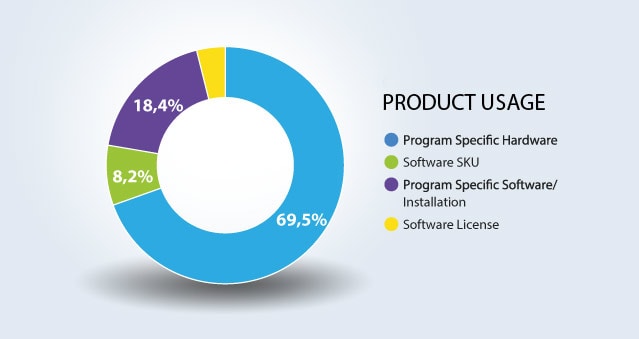Did you know that 61% of software as a service (SaaS) companies have adopted usage-based pricing (UBP)? Also known as consumption-based pricing, pay-as-you-go, time/unit-based pricing, pay per transaction, metered billing, and resource-based pricing, UBP enables customers to pay for products or services based on resources consumed. As the rising star of SaaS pricing, usage-based pricing examples are in every industry. In fact, 80% of customers report better alignment with the value they receive when billed based on usage.
Why Companies are Adopting Usage-Based Pricing
With so many organizations adopting UBP, let’s look at some of the benefits this pricing strategy provides.
- Lowers barrier to entry: Customers can adopt the products or services at a minimal cost and increase usage as needed, expanding the business’ target market.
- Improves revenue potential: As product/service requirements increase, SaaS organizations have a natural upgrade path to take customers to the next tier.
- Increases customer retention: Since customers have more control over their spend, they are less likely to cancel their subscription.
- Enhances customer satisfaction: By offering a pricing structure that easily adapts to the customer’s changing needs, it provides the transparency customers seek – eliminating the feeling that they are paying for unneeded/unused features or functionality.
- Increases investor appeal: While there are several reasons why UBP is appealing to investors, the primary ones are its ability to increase customer lifetime value (CLV) and decrease churn rates.
Usage-based pricing offers the flexibility that benefits both companies and customers alike. Companies gain the ability to adjust pricing based on demand, usage, and other factors, while customers can adjust usage based on their changing needs.
However, there are a few disadvantages. Given that usage is a variable, the organization’s OPEX will also vary which can negatively affect budgets and the company’s ability to accurately forecast expenditures.
Was ist zu beachten, wenn Sie eine nutzungsabhängige Preisgestaltung in Betracht ziehen?
Pricing plays a critical role in the financial health of your business. Get it wrong and you risk leaving money on the table, however, get it right and the business has the potential to exceed revenue projections. If you’re considering UBP, here’s some questions that need careful consideration.
- Do your products and services lend themselves to easily track usage metrics?
- Are your offerings easily scalable?
- Can you provide additional features and functionality to the core offerings?
- How does the pricing metric correlate with customers’ perceptions of the products/services value?
- Will the complexity or simplicity of the perceived value impact the sales process – speed it up/slow it down, make it easier/make it more difficult?
- How does a UBP pricing model compare with the pricing strategies of your competitors?
- What are the pros and cons of adopting a UBP model?
While UBP provides numerous benefits, it’s not right for every company or all industries. Let’s look at some popular usage-based pricing examples and the success they’ve had with this pricing strategy, with many of them seeing an increase in net revenue retention (NRR).
Infrastructure Usage-Based Pricing Example
Snowflake, Inc., a cloud-based data warehousing and analytics company that offers data storage, management, and an analytic solution. Offering a free trial, pricing is based on two factors – the amount of data stored and the amount of computing resources used.
The fee for storage leverages the number of bytes stored per month, as well as the cost of moving data across clouds. The charge for computing is based on the number of credits used to run queries and depends on the plan purchased – standard, enterprise, or business-critical.
Snowflake’s approach illustrates how a data platform can turn metered resources into a competitive advantage through a refined usage-based pricing model. Instead of bundling all functionality into a flat fee, Snowflake separates its costs into two measurable elements that directly reflect user behavior. This structure builds a clear consumption based pricing relationship between customer activity and spending, offering exceptional visibility into cost management.
Pros and Cons
By linking charges to the usage metric of stored data volume and processing intensity, the company helps customers make data-driven financial decisions. Finance and operations teams can easily connect business growth to storage and compute trends, allowing cost forecasting to become part of overall performance tracking.
This system also supports seamless scalability. New customers can begin with small data workloads and expand dynamically as analytics demands grow – demonstrating the adaptive nature of SaaS usage-based pricing. Organizations experience true flexibility: usage expands naturally with need, but costs remain proportional.
That said, this transparency introduces budgeting challenges. While Snowflake’s pricing structure is easy to understand, query volume and compute activity can spike unpredictably, especially during experimentation or seasonal data loads. That unpredictability creates tension between flexibility and control.
Ultimately, Snowflake’s model highlights the balance every SaaS company must strike – enabling freedom to scale without compromising fiscal planning. It’s a clear example of how modern pricing transparency can coexist with complexity in enterprise-scale cloud environments.
Middleware Usage-Based Pricing Example
Twilio is an application programming interface (API) cloud communications platform that provides tools that allow businesses to build and implement communication channels such as SMS, voice, and video into their applications.
They offer four usage-based payment options – pay-as-you-go, volume discounts, committed-use discounts, or a combination of the first three. For instance, their SMS product pricing charges customers a set amount based on the number of messages sent and received.
Twilio’s usage pricing strategy is one of the most recognized consumption- based pricing model successes in the middleware sector. Every SMS, call, or API event represents a measurable cost, aligning directly with the customer’s communication activity. For many organizations, this precision makes budgeting more accurate and encourages optimization.
The flexibility of Twilio’s variable pricing model allows customers to choose from several paths: pay-as-you-go, volume discounts, or committed-use pricing. This adaptability helps the company serve startups that send a few hundred messages a month and global enterprises transmitting millions daily. By scaling charges based on activity, Twilio helps businesses maintain predictable margins while benefiting from communication reliability.
For enterprises managing consistent, high-volume messaging, this system promotes stability. Costs rise in proportion to demand, making it easier to map marketing efforts and customer engagement directly to expenses. Yet, smaller users may experience billing spikes during marketing pushes or seasonal promotions, creating temporary unpredictability.
What stands out most is Twilio’s mastery of usage-based monetization – layering flexibility with structured discount programs. This model proves that when UBP is combined with strategic incentives, it can serve diverse customer tiers effectively while driving consistent revenue growth.
Application Usage-Based Pricing Example
Mailchimp is an email marketing and automation software platform that helps businesses manage their email campaigns. They provide four pricing models – premium, standard (free for 1 month), essentials (free for 1 month), and freemium – each containing various features and functionality depending on the plan selected.
Their strategy represents one of the best examples of a hybrid pricing model in the SaaS market. The company uses email volume as a clear and relatable usage pattern, where cost rises naturally alongside marketing reach. This transparency allows customers to see exactly how activity influences spending – an essential trait for small business owners managing marketing budgets closely.
Mailchimp’s pricing system starts with a freemium tier, encouraging new users to try the platform at no cost. As subscriber lists expand, users graduate into paid plans with higher send limits and advanced automation features. This scaling supports brand loyalty and long-term retention, as customers rarely feel pressure to pay for functionality they don’t yet need.
The clarity of this pricing structure contributes to customer confidence. Businesses sending frequent newsletters or campaign sequences gain predictable monthly costs aligned with activity. However, clients running occasional campaigns might encounter variable bills depending on engagement cycles.
Still, Mailchimp’s model demonstrates the power of blending accessibility with flexibility. By connecting cost to engagement, it creates a natural correlation between value delivered and price paid – showcasing how usage-based systems can foster trust and sustainable growth.
Additional Usage-Based Pricing Examples
Amazon Web Services
Amazon Web Services (AWS) provides on-demand cloud computing platforms and APIs for a wide variety of services, including computing, storage, databases, analytics, machine learning (ML), the Internet of Things (IoT), blockchain, and much more. Each service has its own pricing structure which is based on appropriate metrics like the amount of data stored or amount of computing power used. Customers pay for services consumed, however they can also take advantage of plans like pay-as-you-go, savings plans for select services, and volume discounts.
AWS has refined the usage-based model to accommodate one of the most diverse product ecosystems in the cloud computing world. It monetizes across multiple dimensions providing a spectrum of consumption billing examples that fit virtually every business type.
Pros and Cons
This approach empowers startups, developers, and enterprises to align their spending directly with operational needs. A company launching a single app can start with minimal infrastructure, while a large-scale enterprise can expand usage to thousands of instances across regions. The scalability makes AWS indispensable to organizations pursuing digital transformation.
Yet, such flexibility often introduces significant complexity. Many users struggle to interpret the detailed breakdowns of their recurring billing examples, where hundreds of service lines may appear on a single invoice. To address this, AWS offers tools like Cost Explorer and AWS Budgets to help visualize and manage expenses in real time.
The sophistication of dynamic usage billing at AWS demonstrates both the potential and the pitfalls of flexible pricing. For investors, it represents a growth engine tied directly to customer consumption. For customers, it’s a reminder that the right tools and forecasting strategies are essential for managing long-term value in a usage-based environment.
Zoom
Zoom is a communications platform that allows users to connect via video, audio, phone, and chat. The company offers a variety of plans, including pro, business, business plus, and enterprise, as well as a freemium option. They also provide add-on features like cloud storage, zoom scheduler, and zoom whiteboard for an additional fee.
Given that UBP is not a one-size-fits all pricing model, hybrid pricing strategies are increasingly becoming commonplace. This pricing scheme combines consumption-based pricing and traditional subscription pricing. The blend of pricing models protects SaaS companies from variable revenue forecasting, while capturing incremental revenue from customers that are heavy users of the products or services.
Zoom combines accessibility and flexibility in a variable cost pricing strategy that continues to shape the modern SaaS landscape. The platform’s consumption-based SaaS billing blends a robust freemium model with paid add-ons like cloud recording, enhanced security, and advanced scheduling. This approach invites new users at no cost while allowing heavy users to contribute more as their teams expand.
Pros and Cons
The result is a scalable framework that accommodates individuals, small teams, and global organizations within the same ecosystem. Companies can start free, adopt premium features as needed, and expand usage fluidly. This adaptability builds long-term relationships, as customers stay engaged and upgrade naturally rather than switching providers.
Of course, Zoom’s model isn’t without challenges. Balancing free access with profitability requires careful product planning – too much value in the free version could stall conversions, while limiting it too heavily might slow adoption. Still, the model’s success is evident in the company’s sustained growth and low churn rates.
As one of the most effective scalable usage pricing examples, Zoom illustrates how a thoughtful freemium structure can fuel viral adoption, encourage collaboration, and create consistent revenue flow from usage expansion. This adaptability reinforces Zoom’s place as a prime example of how usage-based pricing drives both engagement and profitability in communications software.
Implementing Usage-Based Pricing
Implementation of UBP can be segmented into three components – departmental collaboration, usage metrics, and deployment steps.
Departmental Collaboration
The adoption of UBP requires collaboration from other departments within your organization. To successfully transition to UBP, be sure to get support from the following:
- Marketing: Incorporating the value of your products and services into your usage metrics needs to be clearly stated across all marketing efforts.
- Sales: Typically, commission is paid once the sale is booked. However, the most successful usage-based SaaS companies have modified this long-standing tradition. In addition to payment made upon the signing of the contract, further incentivize reps with payments based on customers’ increasing consumption.
- Customer Support: As this team interacts with customers after the sale, they must be well-versed on proactively guiding customers on the benefits of increased usage, new features, additional functionality, etc. Additionally, they need to track customer suggestions on requirements and feature requests.
- Finance: Keeping pricing schemes easy to understand needs to be a top priority, but the unpredictability of revenue with UBP can challenge finance teams. Whether pricing changes, the addition of new products or services, the introduction of tiers, or the offering of commitment discounts or volume discounts, be sure your finance team is kept informed. In addition, as you scale, the amount of effort required by your finance team may become laborious and error-ridden, making manual efforts not a viable option. By automating the financial process, you’ll ensure accurate and timely invoicing, account receivables, revenue recognition, collections, and financial reporting.
Usage Metrics
When thinking about the metric(s) to use, be sure to choose the ones that best correlate to the value of your products or services. Additionally, the metric(s) needs to be easy for customers to understand so they can accurately predict cost.
UBP is most often priced on technical metrics, here’s some of the most common usage-based metrics*.
- Compute or CPU: Seconds a virtual machine was active or milliseconds a service was handling a customer request.
- Data transfer: Gigabytes of data that ingress or egress to the provider.
- Data storage: Gigabytes of data held by the provider.
- Uses or queries: Many API service providers will charge based on the number of times the customer accesses it.
- Execution memory: Gigabytes of RAM per second consumed by a service.
- Credits: A prepaid amount of service defined by the provider.
- Other: Software usage may be charged based on specific uses. For example, CRM software may charge based on the number of customer contacts held in the system.
*Source: TechTarget
Deployment Steps
The following steps need to take place before launching a UBP strategy.
- Identify the value metrics: Using data you’ve already accumulated, identify common use cases and the most popular features and functionality of your products or services. Take this one step further by leveraging product usage analytics and digital surveys to gather usage data. Ensure that the metric(s) chosen are scalable and predictable.
- Choose a UBP model: Understanding your offerings and customer requirements is key. Some UBP models to choose from include pay-as-you-go, per unit (pay per use), tiered pricing, event-based, and value-based, or you may opt for a hybrid pricing approach.
- Set up usage limits: Depending on the metric(s) used for pricing, usage limits can take on different forms: GB used, messages sent/received, transactions processed, etc. Once a customer reaches the usage limit, send an automated notification informing them that an upgrade is needed.
- Train the sales team: Training on your UBP strategy is recommended organization-wide, but educating sales reps is especially important so they can educate customers on your UBP model benefits while selling.
- Communicate the pricing strategy: Customers need a clear understanding of the pricing structure, its benefits, and the value they’ll receive. Communicate this through your website, marketing materials and promotional campaigns.
- Track and monitor usage: Tracking usage provides actionable insights into user behavior. This information uncovers what features are popular, customer segments that are heavy users, etc.
- Measure and monitor your UBP strategy: Whether you’re updating your products/services or releasing new features and functionality, continually monitor usage and adjust your value metrics accordingly.
Finally, calculating customer usage manually is unreliable, error-prone, time-consuming and costly. An agile billing solution built to manage today’s complex usage and rating scenarios becomes an essential asset in keeping your company profitable. Especially as the business grows.
Unlock Your Full Financial Potential with Usage-Based Pricing
Real-world usage-based pricing examples have proven time and again how SaaS companies that incorporate this pricing model outperform their peers. In fact, an OpenView Partners study found that usage-based SaaS businesses see continued growth at scale (29.9% vs. 21.7%), and are driven by best-in-class retention (120% vs. 110%). However, rising above the competition takes more than a ‘me too’ approach.
Usage-based billing can quickly become complicated – mediating customer usage, rating customer usage, billing the customer, recognizing revenue, handling dunning, and collecting outstanding payments is error prone, inaccurate, time consuming, and costly when handled manually. A billing system that is purpose-built for usage-based SaaS companies can reduce complexity, give you peace of mind, and ensure that you’re not leaving money on the table.
BillingPlatform’s cloud-based billing platform enables you to aggregate and analyze usage data from any source then transform it into revenue potential – in real time. With us, you get a complete solution that fulfills 100% of your usage-based pricing business requirements, mediation, rating, invoicing, collections, reporting, analytics, revenue recognition, and A/R subledger.
Want to dig a bit deeper? Check out our Executive Overview: Usage-Based Billing white paper.



